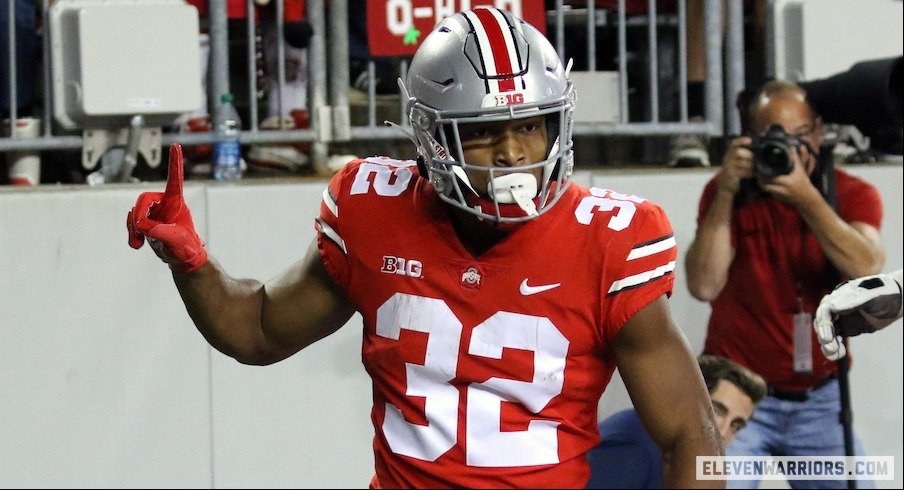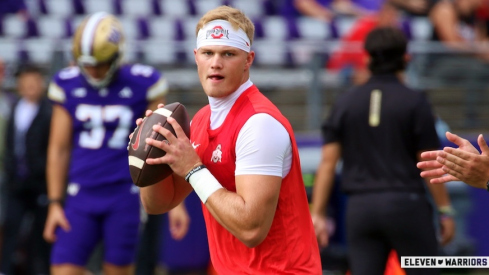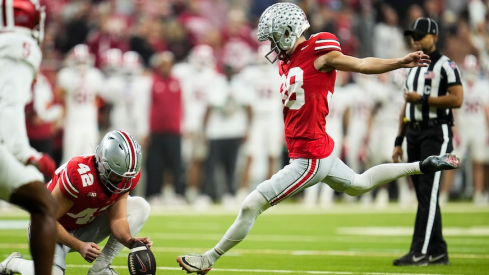Ohio State lands a commitment from five-star DE DJ Jacobs, 247Sports’ top-ranked prospect in the 2027 recruiting class.
In the first seven months that college athletes have been allowed to profit from their name, image and likeness, Ohio State athletes have collectively earned more money than any other athletic department in the country.
According to data from Opendorse that was released by Ohio State as part of a presentation to the Board of Trustees’ legal, risk and compliance committee on Thursday, Ohio State ranks first in the nation in total NIL compensation. Across all sports as of Jan. 23, 225 different Ohio State athletes had disclosed a total of 619 NIL deals for a total value of $2,985,559 since athletes were able to begin profiting off their name, image and likeness on July 1.
Per the Opendorse data published by the university, Ohio State also leads the nation in number of athletes with at least one NIL activity. The Buckeyes rank second nationally in total NIL deals, NIL compensation per activity and percentage of athletes with at least one NIL activity, and third nationally in NIL compensation per athlete.
Football players have made the vast majority of that NIL money – $2,678,893 through 173 total deals – though at least one athlete from every Ohio State sport has landed an NIL deal. Women’s gymnastics athletes have made the most NIL money among Ohio State’s women’s sports, earning a total of $31,767 on 35 total deals.
Ohio State running back TreVeyon Henderson, one of the Buckeye football players who has already had numerous NIL deals, told the Board of Trustees on Thursday that NIL has “completely changed my life forever.”
“Growing up, I watched my mom struggle to take care of me and my two brothers all by herself. All I ever wanted growing up was to be able to give back to her,” Henderson said. “With me now being able to make some real money, I’m now able to take care of myself, take care of my mother and family, continue to invest and put my money to work while I play the game that I love and most importantly, give back.”
Football players have accounted for 27.4% of Ohio State’s NIL deals; women’s volleyball players have had the second-most NIL activities (8.6%), followed by men’s basketball (5.6%), men’s tennis (5.4%) and men’s lacrosse (4.8%).
In social media-driven deals, Ohio State football players have earned an average of $5,968 per Instagram post, $569 per Twitter post and $553 per Instagram story, while men’s basketball players have earned an average of $9,508 per Instagram post, $410 per Twitter post and $124 per Instagram story.
Henderson was one of three athletes who spoke to the Board of Trustees about their NIL experiences on Thursday morning, along with women’s volleyball player Sarah Morbitzer and men’s lacrosse player Mitchell Pehlke. Morbitzer said she has made most of her NIL money by conducting training sessions with local high school volleyball players, while Pehlke said he has made more than $200,000 in NIL money, primarily through his YouTube channel, which has more than 25,000 subscribers.
Ohio State athletic director Gene Smith cited them as three examples of why college athletes being able to profit from their name, image and likeness has been a good thing.
“There’s a great diversity in the opportunities that our athletes have availed themselves of, so while there’s concern and challenges around NIL, this is representative of why it’s good,” Smith said Thursday. “Many of our sports, our student-athletes are on partial scholarships, so many of them leave with debt. This is an opportunity for them to mitigate that, just like other students have, and that was one of the primary planning principles of the name, image and likeness committee that started almost three years ago, that ultimately made the recommendation to implement this, was to provide our student-athletes the same opportunity that our students have on our campus, and them monetizing their name, image and likeness is a result of that.”
Thank you @MitchellPehlke @TreVeyonH4 @SarahMorbitzer for representing all student-athletes at the trustee meeting this morning on #NIL pic.twitter.com/Ipmm8XwUe7
— Gene Smith (@OSU_AD) February 10, 2022
Ohio State football coach Ryan Day also believes NIL opportunities have been great for his players.
“Some of the opportunities that our players have had are in some metrics, they’re No. 1 in the country,” Day said during a press conference last week. “Just with the city of Columbus, the brand of Ohio State, the brand of Ohio State football, some of our guys have really capitalized on this. It’s been tremendous some of the opportunities that they’ve been afforded.”
Both Day and Smith said the first seven months of NIL benefits have been a learning experience for themselves and their athletes, and each of them have continued to express concerns about the lack of national regulations in place, particularly as it pertains to schools using NIL benefits as recruiting inducements.
“Because there’s no national regulations, the inducement and enticements piece in the recruitment process has become problematic,” Smith said. “One of the planning principles of the NCAA and the guardrails was that this could not be used for inducement and enticement to recruit. However, since there’s no national regulations, that is happening. That’s occurring. And we’ve all read stories or heard stories about that, and it’s absolutely true. Different states have different laws and allow it, but other states do not.”
That said, Day said NIL has “become a huge part” of Ohio State’s recruiting pitch over the last six months, even as Ohio State has remained careful – arguably more cautious than necessary in some regards – about abiding by NCAA rules and state laws.
“We have to follow the rules, so we’re gonna be really cautious about that and making sure we’re doing things the right way and be deliberate about what we’re setting up,” Day said. “But Gene’s at the forefront of this to make sure that we’re competing with everybody in the country.”
While the numbers indicate that Ohio State athletes have been successful in landing NIL deals even without direct assistance from the university, Ohio State took another step toward helping athletes secure NIL deals last month with the creation of an “NIL Edge” team, which allows designated administrators – not including coaches – to engage with brands and companies and connect them with Ohio State athletes. Smith felt that was an important step for Ohio State to take, particularly with the rise of donor-led collectives that have sprung up to fund NIL opportunities for specific schools’ athletes throughout the country.
“We decided not too long ago that we needed to have another mechanism to engage and provide access for corporations and individuals, so we can give them better guidance and connect them with student-athletes,” Smith said. “Prior to the Edge team emerging, we did not have a mechanism where a donor or a company could call and we could align them with a student-athlete or a sport. And we’ve been able to do that through the Edge team. We learned a lot prior to implementing this, and we felt comfortable that this was important to implement.”
Although Henderson, one of the nation’s top young running backs, would likely have NIL opportunities regardless of where he went to school, he believes being a Buckeye has increased his market value.
“Being a student-athlete here at The Ohio State University is a big advantage due to the huge support we get from our fan base, alumni and the Columbus community,” Henderson said.


